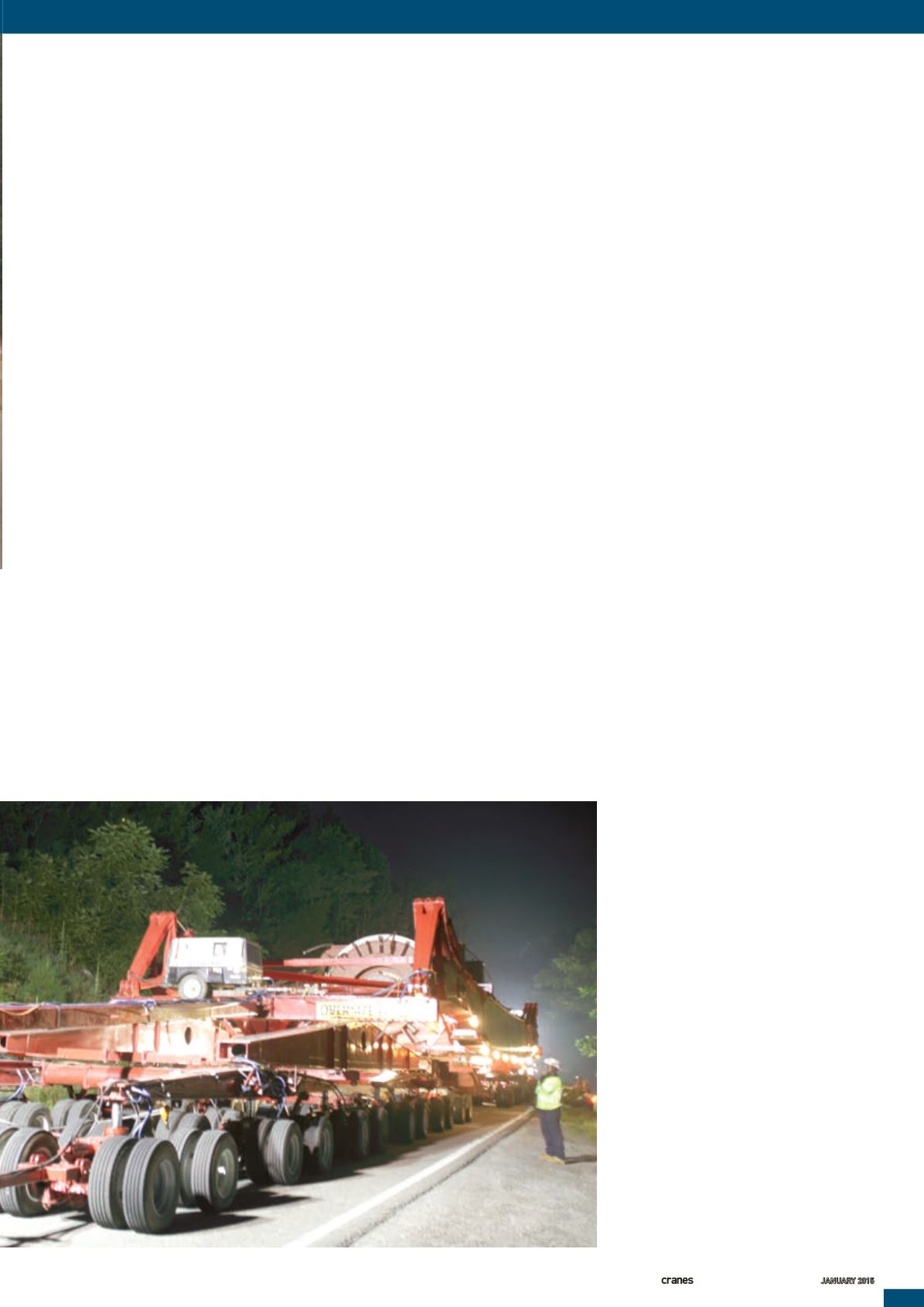
INTERNATIONAL
ANDSPECIALIZED TRANSPORT
■
JANUARY 2015
37
THEKNOWLEDGE
Freq-acceleration=GVW / g *(v / t) =285 / 9.81
* (4.167 / 30) =4.04mTon (8,888LBS) whereg
is thegravitationof 9.81m/s
2
(32.19 ft/sec
2
)
The new required pull force is now:
Freq +Freq-incline +Freq-acceleration=
11.4 +8.54 +4.04=23.98mTon (52,819LBS)
In the chosengear combination the engine
candeliver 39.5mTonof pulling force,
therefore the engine is strong enough in
thisnew scenario and requires only23.98
mTon. The required total rimpull of 23.98
mTon results in a rimpull of 11.99mTon
per axle. This is gettingvery close to the
minimum rimpull of 12mTon atwhich (in
theworst case) the tyreswill start spinning.
Anoption couldbe to add counterweight
to theprimemover just tomake sure
that even in theworst case the tyreswill
not spin.Adding5 tons of counterweight
results in anewminimum andmaximum
rimpull of:
RimPullmin= (5 +40) * 0.6=27mTonor
(Frpaxle) 13.5mTonper driveaxle (29,735LBS)
RimPullmax= (5 +40) * 0.8=36mTonor
(Frpaxle) 18mTonper driveaxle (39,647LBS)
Important calculations
The conclusionof this exercise is that the
transport combination inquestion can
be transportedup a 3% inclinewhile
still accelerating from0 to15km/h in
30 secondswith just a bit of additional
counterweight to avoidwheel spin.
Keep inmind that thesenumbers
assume that the transport combination
is on a straight road and that theprime
mover is in linewith the transporter.
It becomes adifferent casewhen the
combination is negotiating a turn and is
no longer in linewith the transporter.
As a rule of thumb, for every 10degrees
that theprimemover is out of linewith
the transporter itwill lose 10%of its
effectivepullingpower. Thismeans that if
the transport combination in this example
wouldhave tomake a 30degree turn
on ahilly road itwould lose 30%of its
effectivepullingpower andwouldbe able
to transfer only 70%of 39.5mTon=
27.7mTon to the transporter. This is
getting close to the required23.98mTon
that is required.
Such calculations aremore important
thanonewould think at first glance.
Beingon an incline and findingout that
youdonot have enough counterweight
to reach the topputs you in a really
serious situation, especiallywhen traffic
has accumulatedbehind you. It becomes
evenworse if the transport combination
consists of a beam anddolly arrangement
such as inFigure 1.
■
Given is the following engine info:
■
Mack primemover (engine type E7-400)
■
Energy output = 318 kW (426 hp)
■
RPM at energy output = 1,800 permin
■
Max torque = 1,560N*m (1,149 lb*ft)
■
RPM at max torque = 1,200 permin
■
Max RPM = 2,100 permin
■
Min RPM = 475 permin
The ratios of the first five gears (from
the 18 total) of this truck’smain
gearbox are:
■
1st gear 16.42
■
2nd gear 8.78
■
3rd gear 6.28
■
4th gear 4.52
■
5th gear 3.22
The gear ratios of the transfer case are:
■
1st gear 2.37
■
2nd gear 1.24
■
3rd gear 1.00
■
4th gear 0.81
Differential gear ratio 8.27
Efficiency of all gears combined is 90%
The truck has 12.00R24 tyreswith a 24 inch
(609.6mm) radius:
■
total axles = 3
■
drive axles = 2
■
truckweight = 10 tons (equally divided
between front and rear axles)
■
counterweight = 35 tons (on drive
axles only)
Rim Pull min = (5 + 35) * 0.6 = 24mTon
or (Frp axle) 12mTon per drive axle
(26,432 LBS)
Rim Pull max = (5 + 35) * 0.8 = 32mTon
or (Frp axle) 16mTon per drive axle
(35,242 LBS)
We also know that when pulling a 12 axle
hydraulic transporter (weight 40 tons) with
a 200 ton load on it on a level road:
GVW
= truckweight + transporter weight
+ loadweight
= 10 + 35 + 40 + 200 = 285mTon
(627,753 LBS)
With a rolling resistance of 4% or 0.04 the
required rim pull (Freq) is 285 ton * 0.04 =
11.4mTon (25,110 LBS).
We determined that the first auxiliary gear
resulted inwheel spin and that the second
auxiliary gear, with a 1.24 gear ratio,
resulted in a total tractive effort of:
39.5mTon or 19.76mTon per drive axle
(43,538 LBS). This is the drive away gear.
Pulling force
In thenew scenario, with3% incline
and a speedof 15km/h in30 seconds,
the original requiredpull force or
rimpull of 11.4mTon (25,110LBS) is no
longer sufficient.
Additional required pull force due to 3%
incline (Note that 3% is 1.718 degrees):
Freq-incline = GVW * sin(incline) = 285mTon
* sin(1.718) = 8.54mTon (18,820 LBS)
Additional required pull force due to
acceleration (note that 15 km/hr is
4.167m/s):
Figure 1


